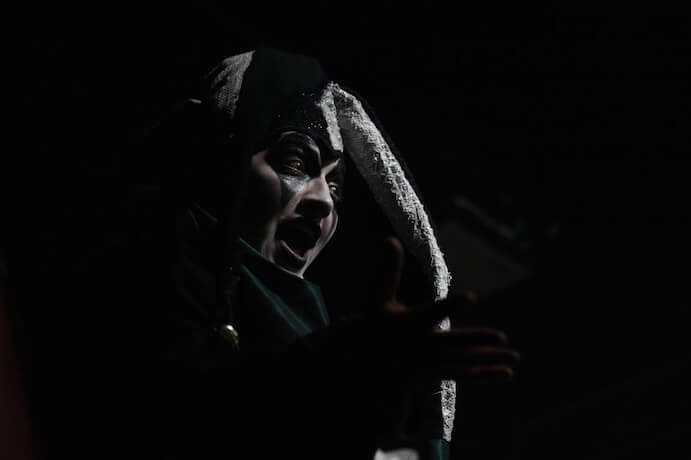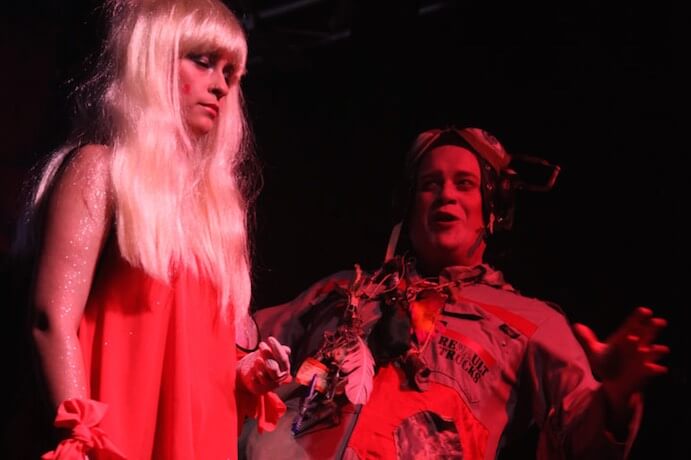Is artificial intelligence taking over? James Oldham and Klara Kofen are billed as co-creators of ‘i’ the opera, though neural network programmers Janelle Shane and Amita Kapoor are also credited for their contributions to the libretto. Oldham and Kofen founded Waste Paper Opera, a collective of musicians and artists who treat genre boundaries playfully and run a cabaret night.
Their 50-minute-long ‘i’ the opera was first performed at London’s Tête-à-Tête festival–a great showcase for emerging opera composers–in August 2017. A slightly reworked version travelled recently to Glasgow, and I attended a performance on 17 May at the Wandsworth Arts Fringe festival in south-west London. The venue was Balham Bowls Club, a former clubhouse in a gentrified corner of London whose present-day inhabitants would only go bowling on a self-consciously retro night out. Decorated with vintage sporting memorabilia, its in-inverted-commas vibe was oddly apposite for ‘i’ the opera, described in the programme as ‘a love story.’
Waste Paper Opera’s wonderfully inventive costumes (by Kofen and Triin Kolmkant) are made of paper or recycled clothes. And for ‘i’ the opera, the recycling goes one step further, as music and text are partly derived from found objects. Amita Kapoor, from the University of Delhi, supplied Janelle Shane with ‘100 of the most flowery romance lines you could imagine, lines from Shakespeare to classic Indian epics’ and this neural network provides some of the text. As for the music, it was partly generated using the Melisma Stochastic Melody Generator and inspired by the experimental poet Christian Bök, whose most celebrated collection is of poems based on a single vowel.

The Jester in ‘i’ the opera–Photography by Al Ritchie and Shitong Zhang
Klara Kofen’s provocative and readable take on artificial intelligence and ‘the aesthetic’ in opera can be viewed here. Anxieties about the slippery border between human and non-human are, of course, not new, and 2018 has provided disturbing new twists. Are the ‘friends’ we’ve never met but interact with on Twitter actually bots? What do social media behemoths know about us? Like so much else, dystopia ain’t what it used to be. Computer programs can create music from ‘Bach’ chorales to ‘Irish’ folk tunes, so why not have one co-create an opera? More precisely, in Kofen’s words, ‘why not give an artificial neural network some creative authority in the writing of a libretto, a score, and the narrative of an opera?’
The theatre stage is framed by oversized statuesque female figures and grand arches painted on paper. A small ensemble of trumpet, violin and two violas (one played by the tailcoat-clad musical director Daniel Galbreath) are joined by sound design (James Oldham) which both beefs up the sonority and underlines the real/simulacrum theme. The (human) ensemble sometimes joins in the stage action with witty interjections or clapping. Oldham’s is a fluent, quirky musical voice, a convincing synthesis of baroque opera conventions, post-minimalism and electronica with jazzy trumpet interjections.
Did I mention it’s also very funny? We open with a jester/narrator/MC (the viola-toned contralto Suzie Purkis) setting the scene. Reiterated vocal phrases are familiar from baroque opera, though stuttering rhythms and recorded sounds, sometimes with a distinctly clubby flavour, suggest this fantasy setting is more contemporary and more skewed. The jester’s ‘Once upon a time’ narrative heralds the entrance of the Princess (countertenor Meili Li) in a curly paper wig, newsprint tutu and flouncy ruff collar. Li’s deadpan delivery made for a perfectly judged comic performance. Her parents, the Queen (coloratura soprano Caroline Kennedy) and King (baritone Themba Mvula–an impressive last-minute replacement) tempt the Princess with a word salad of delights for her birthday, none of which impress the spoilt girl.
But, as the Jester points out, an Inventor (actor Ben Kane) falls from the sky at exactly the right moment. Part-genius and part-everyman, he wears multi-pocketed overalls and an aviator hat and carries a scruffy acoustic guitar. A rubber glove which he inflates piques the Princess’s curiosity and she ‘wants the rest’ of this artificial creature. By typing on his abacus, the Inventor conjures up an Android–a Barbie-type blonde played by singer-songwriter Anna Palmer. ‘Can you make her talk?’ asks the Princess. The Inventor stuffs the Android’s backpack with books and out comes a stream of words (provided by the neural network), randomly at first. The Inventor feeds her material from bird names to snippets of familiar verses (‘Shall I compare thee to a summer’s day?’) to the months of the pataphysical calendar. The Android speaks tentatively as she acquires her language, gradually developing a singing voice. The Inventor is equally hesitant when he serenades her on his guitar or speaks cliched first date banter: the ‘real’ human being is as tongue-tied when it comes to expressing his feelings… He falls in love with her, Pygmalion-style.
The jester introduces a ‘coincidence machine’ which brings back the other characters, a machine set in motion by the Inventor’s heart, flashing in a Perspex box. The King sings an extract of ‘Se vuol ballare’, his Queen erupts in coloratura and the Princess is only momentarily impressed by the Android. Under a capacious parasol, the Android closes the show, singing of love, her voice gaining in power and range and ending unaccompanied.

Anna Palmer and Ben Kane in ‘i’ the opera–Photography by Al Ritchie and Shitong Zhang
Structurally the opera doesn’t fully convince–the Inventor/Android sequence takes over and, compelling though it is, the other characters are forgotten and their reintroduction is excessively brief. But overall, ‘i’ the opera was at the same time tremendously inventive, well-performed and genuinely thought-provoking. I look forward to seeing what Waste Paper Opera come up with next.
The last word should go to the neural network trainer. In her blog, Janelle Shane says neural networks ‘write unintentional humor as they struggle to imitate human datasets. Well, I intend the humor. The neural networks are just doing their best to understand what’s going on.’ Perhaps they are even more like us than we want to believe.






















